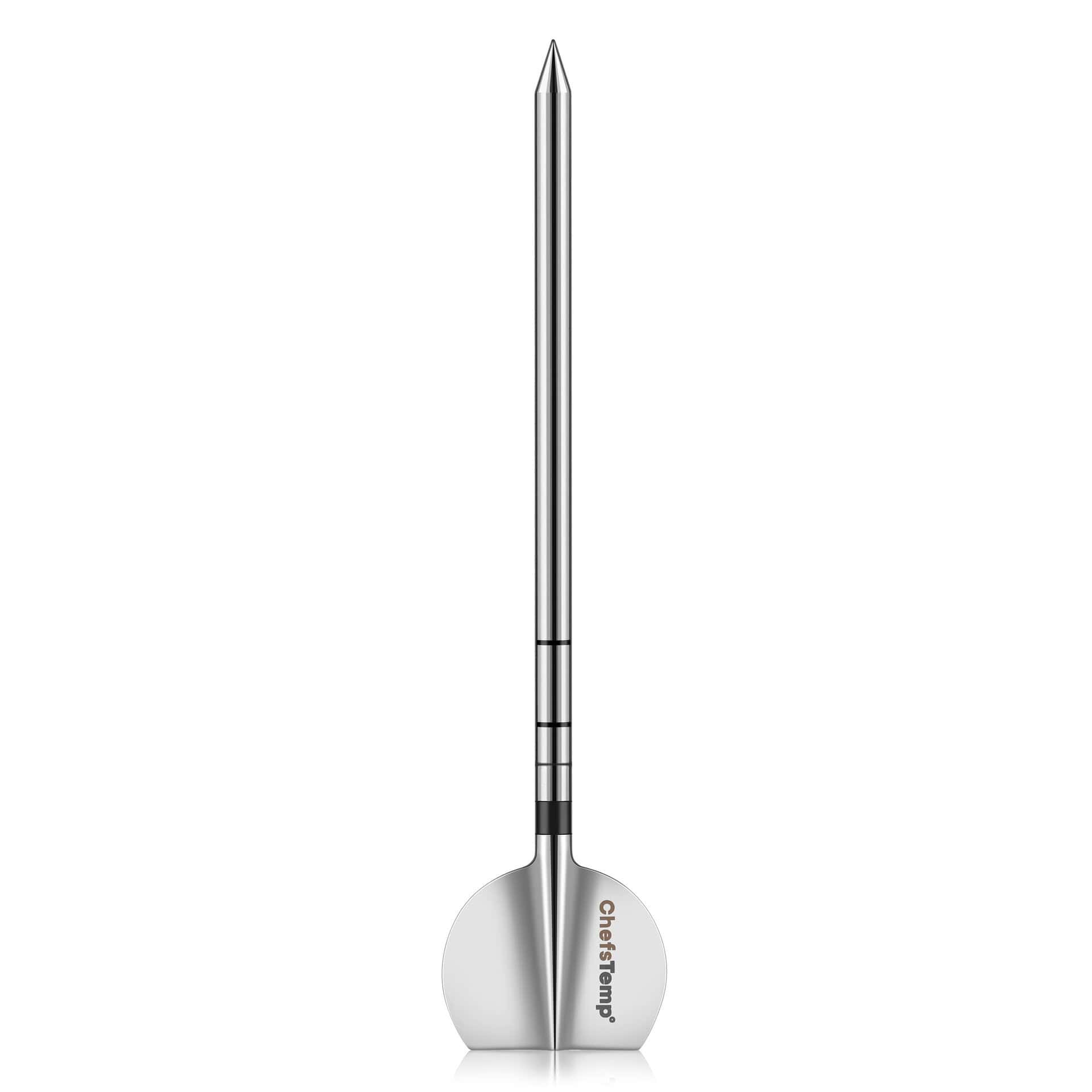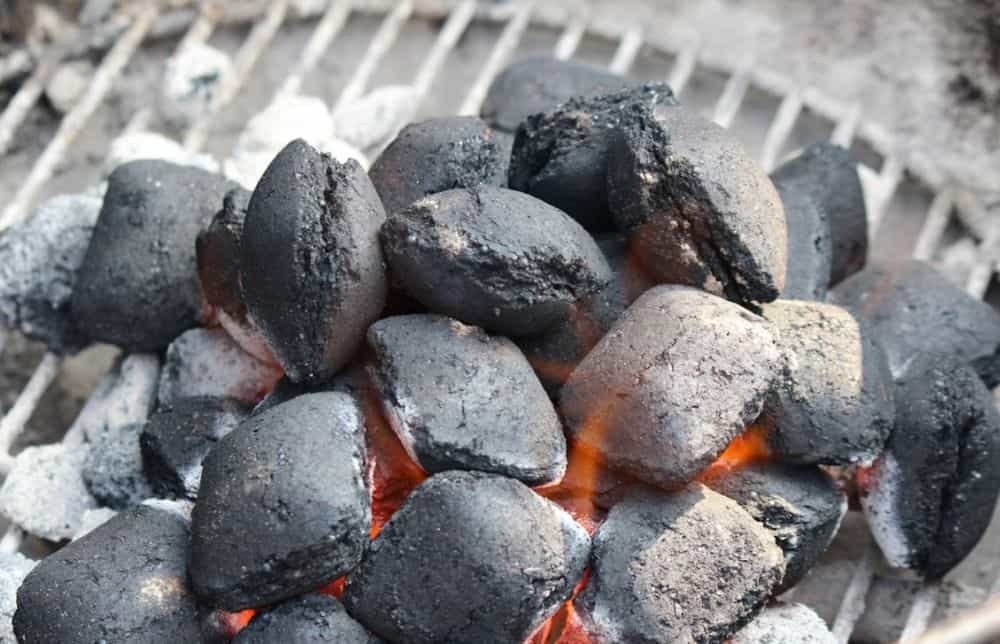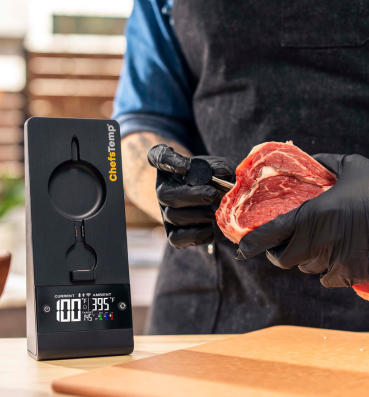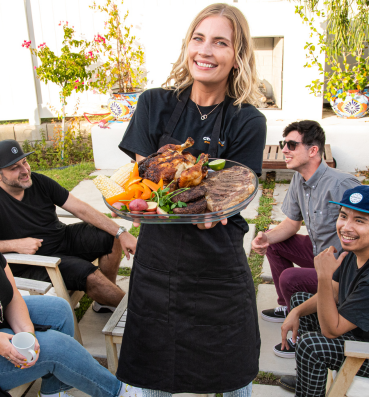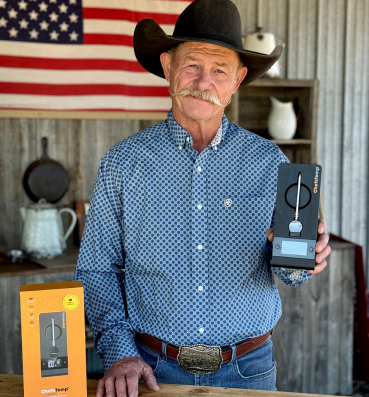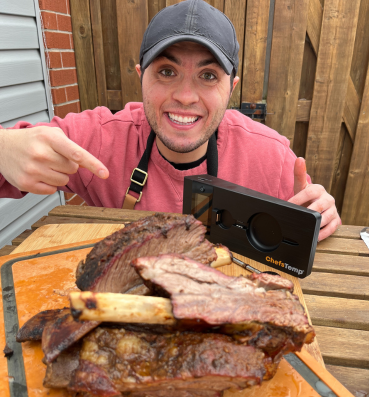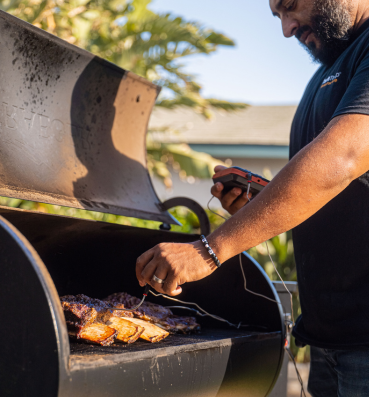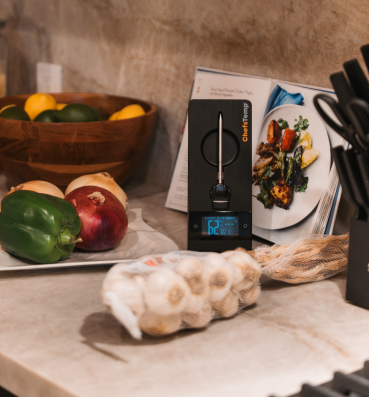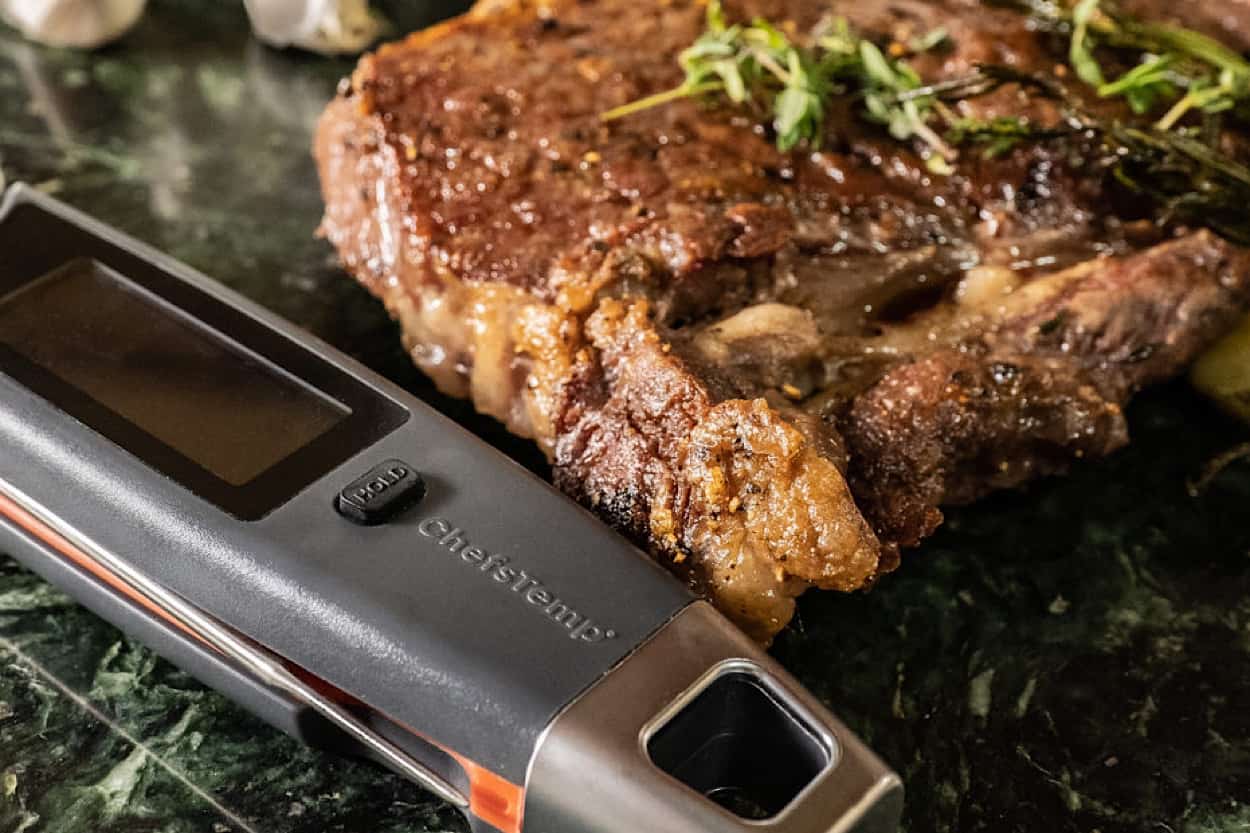
FAQs about BBQ Smoking
Is smoked meat healthy?
Smoked meat is one of the oldest forms of preserving meat. If you observe time and temperature guidelines and fully cook the foods being smoked, the food is going to be as healthy as any other form of dry heat cooking. Smoking uses lower heat over longer periods of time to help break down tough meats with high contents of connective tissue, or for large pieces of meat and whole birds that traditional cooking methods, i.e., oven roasting, would render the meat inedible because to get the meat cooked to a safe serving temperature, the outside of the meat would be burnt or so dry as to render it inedible. Smoking can be applied at the beginning or the end of the cooking process and is used to impart flavor to whatever is being smoked. It can be used to add flavor to salt, cheeses, fish, meats, and vegetables. There are also several types of smoking. Cold Smoking, hot smoking, and wet smoking. Each is used for different applications, but all to do one thing, add the flavor of wood smoke to food.
What are the best woods for smoking meat?
Any wood will produce smoke, but for flavor you want to use hardwoods for smoking. Any hardwood will provide the smoke, however not all hardwoods impart a good flavor. Woods from fruit trees, nut trees, and certain aromatic woods are your woods of choice. Apple, cherry, peach, pecan, hickory, and mesquite are the main woods used these days for smoking. You can use other hardwoods as well, but for the most part they generally only impart smoke as you would get from cooking on an open fire. The wood you choose will have a direct effect on the flavor you seek. I use fruit woods for poultry and fish, they give it a complimentary flavor to the natural flavors of the meats. For beef, pork, and wild game, I prefer to use the heartier varieties like maple, pecan, hickory, and mesquite.
Is it best to smoke meat before or after the sous vide?
To answer this question, one must first understand what the sous vide process is. Sous Vide is a French cooking technique involving foods that are stored in vacuum-sealed bags and then heated or cooked in temperature-controlled water. It is an incredible way to cook foods and to help them retain their flavor and moisture. The process requires some specialized equipment. You need a vacuum sealing machine, an appliance that can maintain the water temperature for long periods of time, a thermometer that can remain immersed to monitor the water temperature and a sous-vide pump to circulate the water. Now that we have a basic understanding of what sous vide is, let us answer the question. Is it best to smoke meat before or after the sous vide? The answer to that question is it really depends on the meat that is being smoked and sous vide. If you use the sous vide process to cook the food from a raw, frozen state, then it is best to smoke it afterwards using the cold smoking process. If you are using the sous vide process to reheat already cooked foods, then smoke the meat before vacuum-sealing and storing it.
Is pine a good wood for smoking meat?
When it comes to woods for smoking meats, spices, and fish, you really want to only use hardwoods, tea leaves, and those types of things. Pinewood, and any of the trees in this genus which includes cedar, are not good woods to use to smoke with. If you are looking for a distinctive pine flavoring, then you would want to use pine nuts, pignoli, or pinyon nuts, otherwise, avoid this wood for smoking. Pine contains pine tar, also known as pine pitch, and when you burn this wood, even as a smoking component, the pitch will taint the food with an undesirable flavor. It will also permeate the inside of your smoker and no matter what you do short sandblasting, cleaning with chemical cleaners like oven cleaner, or steam/pressure washing to remove the pine pitch from your smoker. All woods create pitch, but pine pitch is highly combustible and will eventually cause your smoker to catch fire from the heat generated in the smoking process.
Why is smoked meat important?
Smoking meat is one of several ways used to preserve and flavor meats. The process used is determined by the meat being smoked. Fish is usually cold smoked at low temperatures, 145 degrees f for about 2 hours, other meats like poultry are also smoked for a couple of hours but at temperatures in the 225-275 ℉ range to help with rendering the fat between the skin and the meat and to also help the skin get crisp. Beef and pork are usually hot smoked with or without a water pan, and for long periods of time up to 18 hours. Items like turkeys, hams, and other large cuts or whole birds also require the long slow cooking and smoking process to ensure the meat is fully cooked and tender. The process gives the meat you are smoking a particular flavor, produces tenderness in meats that are tough and need to cook at lower temperatures, in the 225-235 ℉ range to allow the meat to naturally tenderize through the long cooking and smoking process. Rarely are any large cuts of meat smoked for the entire cooking process. Some are smoked at the beginning and some at the end, but the purpose is to impart flavor.
What are the differences between pastrami, corned beef, roast beef, and Canadians’ “smoked meat?”
Understanding the difference between these meats is critical in understanding why they taste so different, even though some of them are from the same cut of meat. Pastrami, corned beef, and smoked brisket are prime examples. All three of these meats are made from beef brisket. It is cut from the beef from between the front legs, each cow has two, they are the pectoral muscles, and because they are highly worked while the animal is alive it is a very tough cut of meat when not handled and cooked correctly. Let us look at the process for each. Corned beef is made by boiling a beef brisket for a certain amount of time with pickling spices and then it is slow-roasted until it reaches an internal temperature of 145℉, then it is pulled, cooled, and then sliced. Pastrami is also made from the brisket, it is boiled but without the pickling spice, then it is cooled, and then coated with crushed black pepper, and then slow-smoked at an exceptionally low temperature until it reaches the desired temperature of 145℉, cooled, and stored. Pastrami is smoked for at least 7 hours and then pulled and wrapped in butcher paper and returned to the smoker and cooked for several more hours. Brisket used for what is known as Texas-style BBQ is slow-smoked for anywhere from 12-17 hours with full smoke for 7 hours, then pulled and cooled, and then is mixed with a sauce to create BBQ. Canadian smoking is used for curing Canadian bacon, which is not bacon at all but is a pork tenderloin, with all the fat and connective tissue removed, is low temperature smoked, below 200℉ for several days, it is cured through the smoking process. This process produced the flavor and texture that have made Canadian Bacon famous throughout the world. Roast Beef is done in an oven, usually set around 325℉. To make a great roast beef you use chuck roast, sear the outside, and then put it into a covered pan with root vegetables and aromatics, and braise it in liquid.
Can you over smoke meat?
The simple answer to this question is yes, you can over smoke meat. This question does merit a deeper explanation, however, and therefore we must investigate what smoking does and how it affects the flavor. Smoking takes wood smoke, and because it has the characteristics of the wood used, imparts that flavor to the meat. That is the purpose of smoking. But what it is doing is changing the physical structure of the meat along with the application of heat to take the meat from a raw, inedible state to a finished, delicious product that you and others will enjoy. Smoking is a controlled process, with temperature and time being critical to producing the type of meat you are trying to accomplish. It also creates tenderness because smoking is a lower heat cooking method and lends itself well to fatty and tough cuts. Because the process is slow, the fat renders out and produces flavor and tenderness as it cooks and carries the smoke flavor into the meat. Well, smoked meats have a pink ring at the outer edge, and it is this ring you are looking for to tell you the smoking was done properly. Each kind of meat has a different time, temperature, and smoke time involved and will require some charts or books to help you attain that perfect smoke process. The internet is full of helpful charts you can download or print.
Why are people so crazy about smoking meat?
Simply put, Flavor!!! If you have ever had food, especially meat cooked over an open wood fire, you will know the taste is not only delicious but can spoil you to wanting that flavor. In our modern world, with all our technology, the flavor of smokey meats has almost been lost. Home smoking and cooking have resurrected the art of smoking meats and doing it without additives to produce time-honored, traditional foods is almost an art form. Today we go to the grocery store, and we buy smoked sausage, hickory smoked bacon, smoked oysters, all types of smoke-flavored foods, most of which are made by adding smoke flavoring. People love smoked foods, and with the affordable home smoker, people have returned to smoking meats.
What are the easiest mistakes to make when smoking meat?
Smoking meats is almost an art form, and anyone who wants to smoke their own meats has some studying to do and to investigate getting recipes designed specifically for smoking meat. The excitement from the smell of the smoke and the aroma of the cooking meat is intoxicating, and it does tend to cause a novice to get excited and to make some easily avoidable mistakes. One of the easiest mistakes to make is getting in a hurry. Most of us cook on stoves with ovens and because a smoker is a closed device, we assume that it will cook at the same speed as an oven, which is not true. If anything, smokers require more time, and depending on what kind of smoker you have, constant monitoring and tending to a fire must be kept going to maintain temperature. The second mistake people make is that they constantly open the door to see if the food is done allowing the heat and smoke to escape. Both increase the cooking time exponentially because you now must allow the smoker to get back up to temperature and possibly add more wood for smoke. Smokers require time to cook and need to remain closed for the smoke to penetrate the meat.
Are nitrite-free smoked meats worse for you?
Nitrites are added to meats to cure them, sodium, and potassium nitrate draw moisture out of the meat and give it a distinct pink color. Nitrites have been used for a couple of centuries to speed the curing process prior to smoking the meats. Nitrite free meats are cured with smoking and drying, and even salting or brining without curing salt. Curing salt as it is known, is pink in color, and is either sodium or potassium nitrite. These additives do aid in the curing process, but they also help develop triglycerides in the foods. Commercially cured meats rely heavily on nitrites to accomplish the curing, where in home-cured and smoked meats following traditional techniques use time, temperature, and air to do the curing prior to smoking. Some examples are Parma Ham and Prosciutto. These are salt or salt and sugar-coated, air-cured meats.
Why does smoked meat taste good?
Smoked meats taste good because of the wood used, the spices and herbs used, and a lot of times, sugar, brown sugar, or honey that is used to add flavor components to the meat. If you took the meat and did not apply a rub, marinade, or spritz it, you would have meat that is carrying only the flavor of the smoke and it would keep the incredible flavor compounds from developing. Different kinds of meats require different processes prior to smoking to bring out the flavor. Adding citrus, honey, molasses, sugar, brown sugar, salt, pepper, pepper blends, allspice, cinnamon, paprika, etc., all increase the flavor of the meat. Other things to add are chile powder, ground chilies, herbs, and dehydrated onion and garlic in either the form of granules or powders. These seasonings add character to your smoked meats and add to the flavor we associate with smoked meats.
How long does smoked meat last?
Most smoked meats are only cooked, not cured, once you finish your smoking process, if you want the meat for later on, you need some way of vacuum sealing the meat, or to use Ziploc style bags and push the air out, once you have done that, you should be able to store it safely in the freezer for at least 6 months, but if you refrigerate it, you have roughly seven days. Smoke cured meats take several days to accomplish and you have to maintain a constant temperature and smoke to effectively cure the meat, a prime example is Canadian style bacon, which takes about six days, after bringing it for three days, you have to smoke it at lower temperatures, around 150℉, and to keep it safe you have to get it above 135℉ and keep it there until the curing process is complete. Smoke curing is done by what is referred to as cold smoking.
Is meat smoked yourself healthier than store-bought “smoked” meat?
Home smoked meats vs store-bought. The difference between these is important to understand the nature of the question. Home smoked meats normally do not contain any additives or preservatives. They are done with smoke, salt, and seasonings, usually do not contain MSG, caramel coloring, or any nitrites or preservatives outside of salt. This makes them healthier when done right and according to safe food handling procedures. Commercially smoked meats a lot of times are not even smoked but have smoke flavoring added and are simply cooked. A prime example is a kielbasa sausage. When smoked at home the texture is completely different than a kielbasa purchased from a store. Not only is the texture different, but the flavor is completely different.
Is smoked meat bad for the elderly?
This is a difficult question. First, smoking meats is one of the oldest known methods of preserving meat. People have been eating smoked meats for thousands of years. It was not until the introduction of preservatives, and nitrite curing that smoked meats became considered a health risk. Also, certain types of woods are known to produce more carcinogens than others, and smoking in comparison to grilling under high heat, and other forms of high heat cooking like deep frying and broiling, produce more carcinogens than wood smoking meat. True smoking is a lower temperature process and contains fewer carcinogens when using woods like hickory, apple, cherry, mesquite, pecan, or any combination of hardwoods. Beechwoods produce much higher quantities of carcinogens and should be avoided. Smoked meats do contain carcinogens, but the concentration of carcinogens is a major concern, and avoiding woods like beech, and other similar woods reduces the concentration of carcinogens greatly.
Is smoked meat safe to eat every day?
The safety of consuming smoked meats daily is a concern that has proponents for both sides. One thing though that should always be considered in answering this question is: first, was the meat smoked at home without commercial additives? The second was the meat slow-smoked or high heat smoked? The third was the meat grilled or broiled? All these questions need to be answered to answer the question, however, people have been eating smoke-cured meats for thousands of years and until the introduction of nitrates and preservatives to extend shelf life and enhance flavor, smoked meats were eaten daily. When it comes down to it, the answer to the question of is smoked meat is safe to eat every day is based totally on what type of wood was used to create the smoke. Also, commercial smoke flavorings will add a level of antimicrobial protection to the smoking process as well.
What is the ideal temperature for smoking meat?
The answer to this question is based entirely on what meat are you smoking? Fish must be cold smoked. Cold smoking is done between 135 and 150℉ just above the temperature danger zone. Low heat smoking is done between 150 and 175℉ and is used more for dehydrating than for actual smoking, a prime example would be making meat jerky, smoked bacon, Canadian-style bacon. Higher heat smoking, between 175 and 275℉ is what most people think of when you say smoked. This is the temperature range for meats like brisket, ham, pulled pork, smoked pork loin, etc. with the ideal smoking temperature between 200 and 225℉. This allows you to get the meat above the temperature danger zone, 41-135℉, and to render the fats, imbue the meat with smoke flavoring, and allows the connective tissue to breakdown and the meat to become tender.
Why does my smoked meat taste bitter?
This is a question often asked and the answer has many factors, but one of the main reasons for bitter-tasting smoked meat is it was smoked too long, the wood used was the wrong wood, and the seasoning used were either not fresh, had something in them, or the wrong combination was used. Remember, the smoking process is two parts, smoke, and heat. Usually what happens is people who are new to smoking have not learned that the smoking process is usually half or less of the total cook time. For example smoked brisket, you smoke the brisket for 6-7 hours, but the total cooking time is 10-17 hours. Too much smoke will make the meat taste bitter. It is important to find a reliable smoking chart and follow it. Other people with vastly more experience smoking meats have worked out all the problems by providing smoking charts, these have not only smoke time, but also cook time and temperature to achieve the results you are looking for, as well as what kind of wood chips or pellets to use to achieve the desired taste. The other thing is to check the expiration dates on the herbs and spices you are using. They too have a shelf life and at the end of their shelf life, they can become bitter.
What are some useful tips for someone who is new to smoking meats?
Tip #1 – get a reliable smoker. You need a smoker that you can maintain the correct temperature with, you also need it to have some sort of smokebox, and a way to have a water pan placed in the smoker.
Tip #2 – get a reliable instant-read thermometer like the ChefsTemp Final Touch and get a roasting multi-probe digital cooking thermometer like the Smartro ST54. These will help you maintain perfect cooking temperatures.
Tip #3 – use good quality meat, the better the quality of meat, the better the final product will be.
Tip #4 – do not get in a hurry. Smoking meat is a long process, rarely under two hours, usually closer to ten, so get relaxed, set aside the time needed, and settle in, it is going to take a while, and getting in a hurry will only make for a bad experience.
Tip # 5 – get some good reference charts for cook time, smoke time, and cooking temperature.
Tip #6 – you are going to need good knives, good cooking utensils, heat-resistant gloves, meat claws, and refrigerator space. A lot of smoking requires marinading overnight, wet and dry brining overnight, and cold curing.
What is the difference between smoking and barbecuing meat?
Great question. Smoking is a long process using lower heat and wood smoke to produce meat that is ready to eat, cured through the smoking process, and for tough cuts of meat to help them get tender through the long cooking process, it is also how you cold smoke fish, cheese, salts, and any other food item you want to have smoke flavor including dried vegetables and chilies. A chipotle is a dried, smoked jalapeno. Barbecuing is another name for grilling. Grilling is using high heat to cook relatively thin meats, steaks, chops, ribs, and fish and shellfish, at higher temperatures. It differs from smoking mainly in you must closely monitor the foods, turn them constantly, spritz them with different liquids to prevent burning, and must keep the fats from igniting and burning the foods. Barbecuing (grilling) is done with open flame and having the food suspended above the flame but really close to the flame and when the fats render, they are highly flammable. Keep a spray bottle at hand and NEVER, EVER walk away and leave the grill unattended, that is flirting with disaster. Grease fires are next to impossible to extinguish, and you really want your time to be enjoyable, no need for the fire department to attend your BBQ.
What is the danger zone when smoking meat?
This is a critical question, and the answer is simple, the danger zone for any food is 41-135℉. Keeping food safe means you must move the food through that temperature range in 4 hours or less. Once the meat is above 135℉ and you maintain the temperature, then you are well on your way to getting the most amazing, wonderfully smoked foods that will be the envy of your guests. It is important to do several things to prepare for this,
#1 – preheat your smoker and have your smoke ready before you place the meat in the smoker to smoke.
#2 – try to allow your meat to come up to room temperature before you put it in the smoker. This will decrease the time spent in the temperature danger zone and keep your food safe.
#3 – resist the urge to open the smoker during the smoking process. Every time you open the smoker, you are lowering the temperature and releasing the smoke and you have to get the smoker back up to temp and add more smoking matter to the smokebox to replenish and re-establish the smoke content and heat inside the smoker.

Finaltouch X10
The Finaltouch X10 thermometer from ChefsTemp gives an accurate reading not only for the inside of food but for surface temperatures as well. The diversity of the thermometer’s usage is second to none compared to other thermometers. By getting a reading within 1 second, the Finaltouch X10 from ChefsTemp is prepared to take on any task it is given.
Discover Other ChefsTemp Products
Discover more recipes and learn kitchen tricks by joining our cooking family on Facebook.
You may also like:

